Por defecto, WordPress muestra las entradas de su blog en la página de inicio. Sin embargo, si usted está haciendo un sitio web de negocios o simplemente desea personalizar su página de inicio, entonces es posible que desee una página separada para su sección de blog.
Esta configuración no solo le ayuda a mantener su página de inicio limpia y centrada, sino que también proporciona un espacio dedicado para que los lectores exploren el contenido de su blog.
Para mejorar la experiencia del usuario y mantener un enfoque claro en nuestras ofertas, hemos añadido páginas de blog separadas en muchos de los sitios web de nuestras empresas asociadas, incluyendo WPForms, OptinMonster, y All in One SEO. Esto permite a los visitantes acceder fácilmente al contenido del blog, al tiempo que se da prioridad al objetivo principal de promocionar nuestros plugins.
En este artículo, le mostraremos dos formas de crear una página separada para entradas de blog en WordPress.
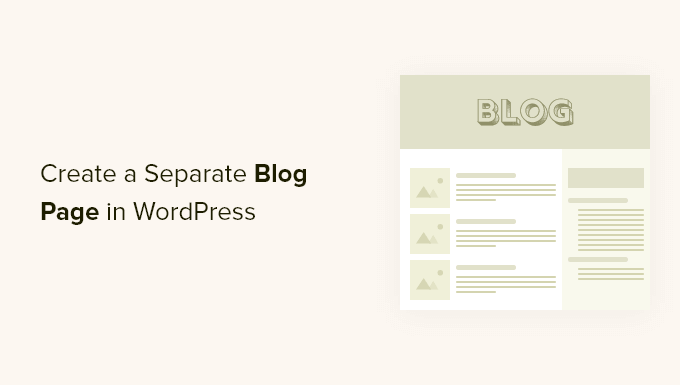
¿Por qué mostrar las entradas del blog en una página aparte?
La página de inicio es la página principal de su sitio web WordPress y la primera página que ven sus visitantes. Por defecto, WordPress muestra tus entradas más recientes en tu página de inicio, y eso tiene sentido si tienes un blog.
Pero no siempre es ideal para sitios web de pequeñas empresas. Probablemente querrá una página de inicio más atractiva que informe a los usuarios acerca de su negocio, productos y servicios, les permita saber cómo ponerse en contacto con usted y aumente la conversión de sus ofertas.
Ahora bien, si también quiere tener un blog en su sitio web, entonces tendrá que proporcionar otra página donde los visitantes puedan ir a leer sus entradas.
Dicho esto, le mostraremos cómo crear fácilmente una página separada para entradas de blog en WordPress.
En este tutorial, hemos discutido dos métodos, y puede utilizar los enlaces de abajo para saltar al método de su elección. Tenga en cuenta que el segundo método es el más sencillo y ofrece la mayor personalización:
Tutorial en vídeo
Si prefiere instrucciones escritas, siga leyendo.
Método 1: Crear páginas separadas para entradas de blog en WordPress
Puede crear una página separada para las entradas del blog utilizando los ajustes por defecto de WordPress.
Sin embargo, este método requiere un poco más de trabajo que el método 2 y no ofrece tantas opciones de personalización.
Crear una página de inicio y una página de blog separadas
En primer lugar, debe crear dos páginas de WordPress separadas para utilizarlas como página de inicio / página de blog.
No tiene que añadir ningún contenido a esas páginas y puede ponerles el nombre que quiera. Por ejemplo, algunos sitios web de empresas utilizan “Noticias” para su página de blog.
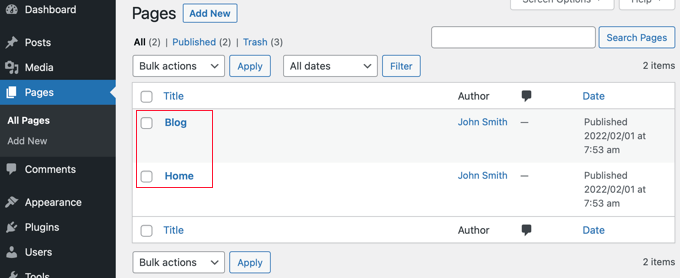
Una vez que haya creado esas páginas, visite la página Ajustes ” Lectura en el área de administrador de WordPress.
En la sección “Su página de inicio”, haga clic en el botón “Una página estática”.
A continuación, puede seleccionar las páginas de inicio y blog que creó anteriormente. A continuación, desplácese hacia abajo y haga clic en el botón “Guardar cambios”.

Ahora, cuando navegue a la pantalla Páginas ” Todas las páginas desde el escritorio de WordPress, verá que la página de inicio está etiquetada como ‘Página de inicio’ y la página de blog está etiquetada como ‘Página de entradas’.
Haz clic en el enlace “Ver” situado bajo la página del blog para obtener una vista previa.
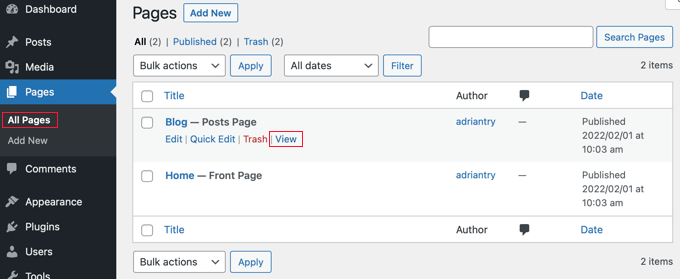
La apariencia de estas páginas depende de su tema de WordPress, y puede que desee establecer estos ajustes.
Por ejemplo, si tu tema tiene un menú de navegación, entonces notarás que WordPress ha añadido automáticamente las nuevas páginas de blog y de inicio. Si no es así, consulte nuestra guía para principiantes sobre cómo añadir un menú de navegación en WordPress.
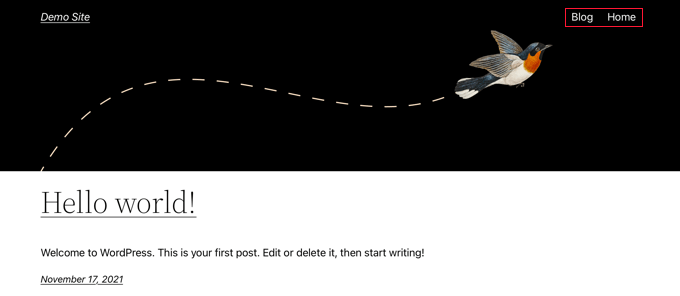
Personalizar la página de inicio / página de inicio
Hasta ahora, su nueva página de inicio está en blanco. Ahora es el momento de añadir información acerca de su empresa, productos y servicios, y de indicar a sus visitantes cómo pueden ponerse en contacto con usted.
Puedes aprender cómo hacerlo en nuestra guía sobre cómo crear una página de inicio personalizada en WordPress. En el Método 1, te mostramos cómo utilizar el editor de bloques para añadir imágenes de portada, columnas, tablas, texto y medios, galerías y mucho más.
También encontrará muchas ideas creativas de personalización en nuestra guía sobre cómo editar una página de inicio de WordPress de forma fácil y eficaz.
Personalice la página de su blog
Si está satisfecho con el aspecto de la página de su blog, el trabajo ha terminado.
Sin embargo, si está utilizando un tema basado en bloques, también puede personalizar la página de su blog visitando la pantalla Apariencia ” Editor desde el escritorio de WordPress.
Una vez allí, seleccione la opción “Páginas” en la columna izquierda del editor del sitio completo.
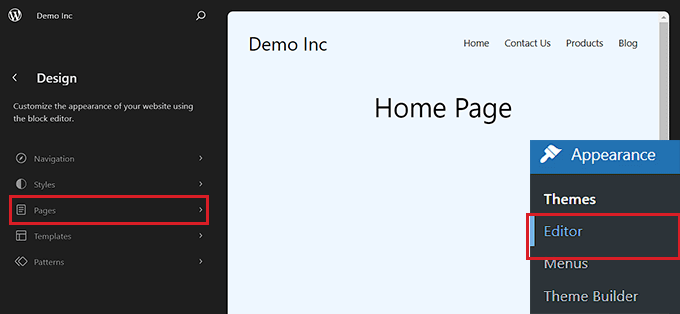
Se abrirá una lista de todas las páginas de su sitio web en la columna de la izquierda.
Desde aquí, seleccione la opción de página “Blog” y, a continuación, haga clic en la vista previa de la página de la derecha para empezar a personalizar la página de su blog.
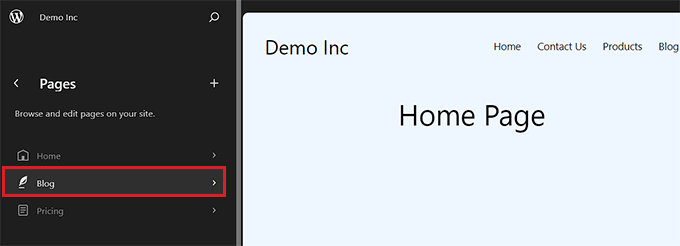
Ahora puede hacer clic en el botón “+” de la esquina superior izquierda de la pantalla y añadir los bloques que desee a la página.
Además, puede cambiar el fondo, el texto o el color de los enlaces de la página de su blog haciendo clic en el icono “Estilos” situado en la esquina superior derecha de la pantalla.
Se abrirá un panel de bloques a la derecha desde el que podrá hacer clic en la pestaña “Tipografía” para cambiar el color del texto, en la pestaña “Colores” para cambiar el color de fondo y en la pestaña “Disposición” para configurar las dimensiones de la página de su blog.
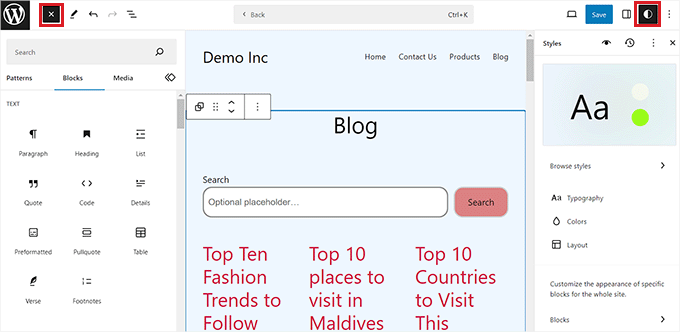
Cuando hayas terminado, no olvides hacer clic en el botón “Guardar” de la parte superior para guardar tus ajustes.
Ahora, puedes visitar la página de tu blog WordPress para ver cómo queda.
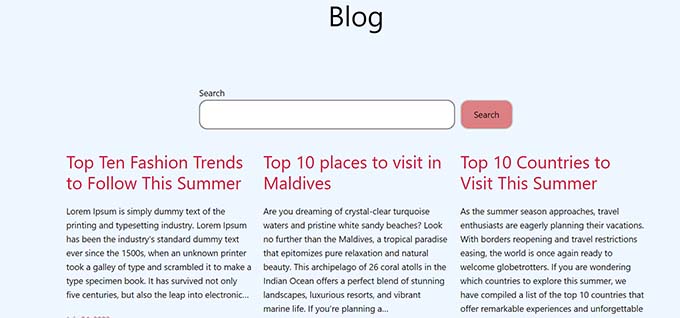
Sin embargo, si utiliza un tema clásico, deberá utilizar el método 2 para personalizar la página de entradas de su blog.
Método 2: Creación de una página personalizada para entradas de blog con un maquetador de arrastrar y soltar (Recomendado)
Un plugin maquetador de temas permite crear fácilmente un tema de WordPress personalizado sin necesidad de código. Esto incluye la posibilidad de crear y personalizar una página independiente para las entradas del blog.
Instalación del maquetador de temas SeedProd
Primero, necesitas instalar y activar el plugin SeedProd. Para más detalles, consulte nuestra guía paso a paso sobre cómo instalar un plugin de WordPress.
SeedProd es el mejor editor de arrastrar y soltar página de WordPress para empresas, bloggers y propietarios de sitios web. También cuenta con un diseñador de temas que te permite personalizar fácilmente la página de tu blog y mucho más.
Puede leer nuestra reseña / valoración completa de SeedProd para más detalles.
Tras la activación, visite la página SeedProd ” Ajustes para introducir su clave de licencia. Puede encontrar esta información en su cuenta del sitio web de SeedProd.

Después de eso, es hora de crear un tema de WordPress personalizado. Esto es mucho más sencillo de lo que parece.
Creación de un tema de WordPress personalizado
En primer lugar, debe visitar la página del maquetador de temas de SeedProd. Aquí, usted utilizará uno de los temas listos de SeedProd como punto de partida. Esto reemplazará su tema de WordPress existente con un nuevo diseño personalizado.
Puede hacerlo al hacer clic en el botón “Temas”.
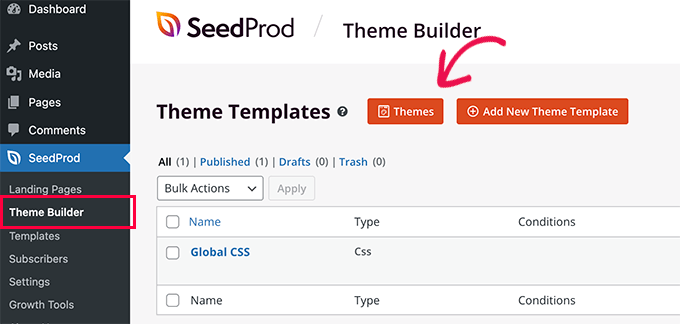
Ahora se le mostrará una lista de temas diseñados profesionalmente para diferentes tipos de sitios web.
Por ejemplo, hay plantillas denominadas “Empresa moderna”, “Agencia de marketing” y “Tema de agente hipotecario”.
Eche un vistazo a las opciones y seleccione la que mejor se adapte a sus necesidades al hacer clic en el icono de la marca de verificación.
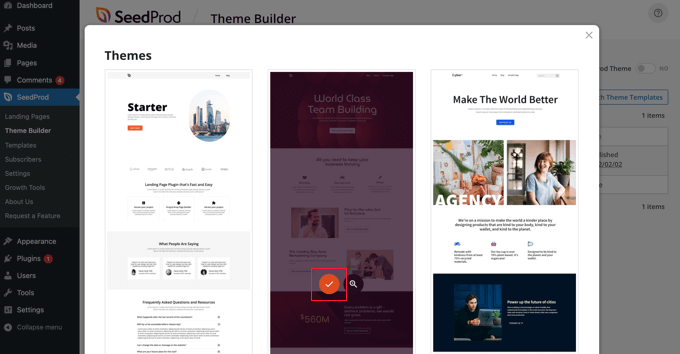
Una vez que haya elegido un tema, SeedProd generará todas las plantillas de temas, incluyendo una para el índice de su blog y otra para su página de inicio.
No se trata sólo de páginas vacías, sino que vienen establecidas con atractivas disposiciones y marcadores de posición de contenido fáciles de personalizar.
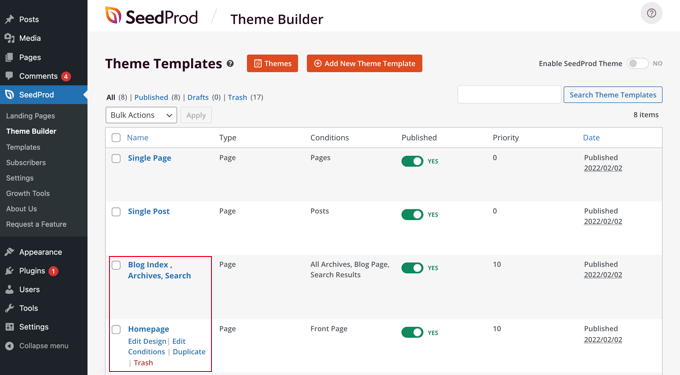
En este tutorial, le mostraremos cómo personalizar las plantillas de la página de inicio y del índice del blog.
También puedes personalizar las otras plantillas. Para saber cómo hacerlo, consulta nuestra guía para principiantes sobre cómo crear fácilmente un tema de WordPress personalizado.
Personalizar la página de inicio / página de inicio
Una vez que haya generado sus plantillas de temas, puede editarlas utilizando el maquetador de temas de SeedProd. Comenzaremos con la plantilla de página de inicio.
Para empezar, sólo tiene que enlazar el enlace “Editar diseño” situado bajo la página de inicio.

Esto iniciará el archivo de plantilla en el maquetador de temas de SeedProd.
Este sencillo maquetador de arrastrar y soltar mostrará una vista previa en vivo de su página a la derecha y una barra de herramientas de bloques a la izquierda.
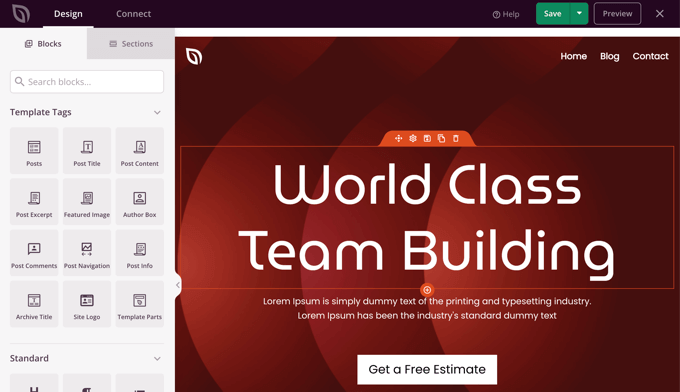
Puede personalizar cualquier bloque al hacer clic en él, arrastrar bloques arriba y abajo con el ratón y añadir nuevos bloques a la página.
Hemos escrito una guía completa sobre cómo crear una página de inicio personalizada en WordPress. Simplemente desplácese hacia abajo hasta el Método 2 para aprender a personalizar su página de inicio utilizando SeedProd.
Personalice la página de su blog
El maquetador de temas de SeedProd también ofrece muchas formas de personalizar la página de índice de tu blog.
Al hacer clic en el enlace “Editar diseño” situado debajo de la página, podrá empezar con los primeros pasos.

Verás el mismo panel de vista previa a la derecha y la barra de herramientas a la izquierda. Puede personalizar la página de blog del mismo modo que lo hizo con la página de inicio.
Por ejemplo, al hacer clic en el titular, podrás ver todos sus ajustes. Puedes editar el texto, cambiar la alineación y el tamaño de la fuente, y mucho más.
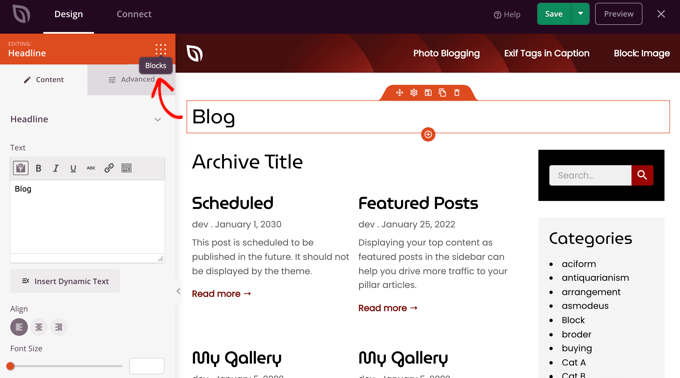
Cuando hayas terminado, tendrás que hacer clic en el icono “Bloques” para volver a la barra de herramientas.
El maquetador de temas SeedProd ofrece bloques adicionales de partes de plantillas, como el bloque Entradas, que muestra una lista de las entradas de tu blog.
El bloque Entradas ya se ha añadido a la plantilla de índice del blog para ti, y en esta plantilla, el bloque muestra tus entradas en dos columnas. Podemos cambiar esto a una sola columna.
Simplemente haz clic en el bloque Entradas y cambia el ajuste “Columnas” a 1.
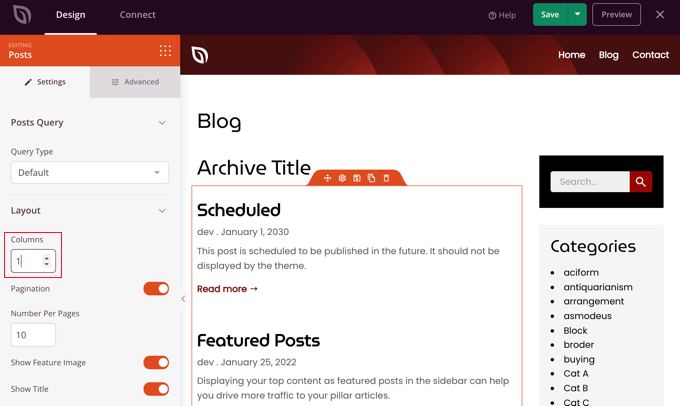
La estructura / disposición / diseño / plantilla cambiará inmediatamente a una sola columna.
A medida que te desplazas por los ajustes del bloque Entradas, encontrarás conmutadores que te permiten elegir si mostrar o no la imagen y el título de la característica de la entrada. También puedes elegir qué etiqueta de cabecera utilizar para el título de la entrada.
También hay opciones para mostrar distintos metadatos de las entradas. Puede conmutar la fecha de modificación, el autor, la fecha y hora de publicación y el recuento de comentarios.
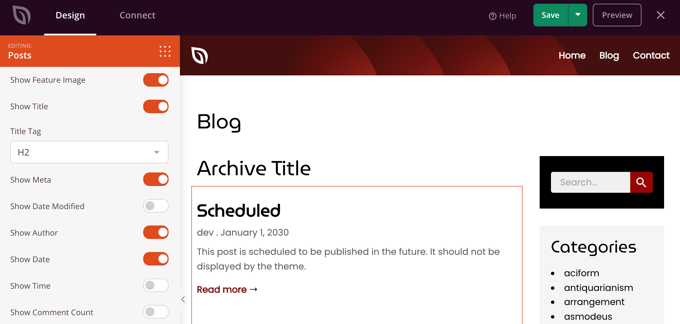
A continuación le ofrecemos otras formas de personalizar el índice de su blog:
- Puede filtrar el índice por tipo de entradas, categoría, etiqueta o autor.
- Se puede cambiar el orden / orden de las entradas.
- Puede elegir cuántas entradas se muestran en una página.
- Puede conmutar el extracto de la entrada y personalizar su longitud.
Cuando haya terminado de personalizar la página de su blog, asegúrese de hacer clic en el botón “Guardar” situado en la parte superior de la pantalla. A continuación, puedes volver a la lista de plantillas al hacer clic en el icono ‘X’.
Activar el tema SeedProd
Una vez que haya terminado de personalizar las plantillas de temas, deberá publicar el nuevo tema personalizado.
Sólo tiene que establecer el conmutador “Activar tema SeedProd” en la posición “SÍ”.
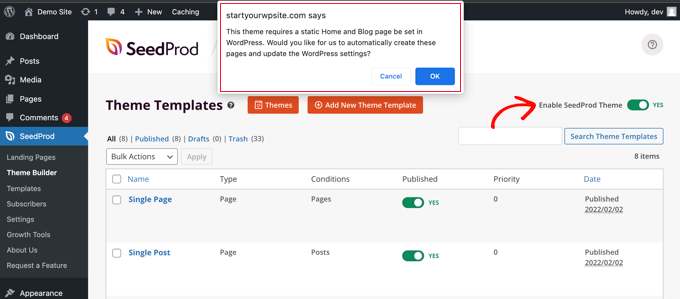
Inmediatamente verá un aviso de que es necesario cambiar los ajustes de la página de inicio / blog de WordPress. Al hacer clic en el botón “Aceptar”, se modificarán estos ajustes.
Ahora puede visitar su sitio web para ver su nueva página de inicio / página de blog. Este es el aspecto de la página de índice del blog en nuestro sitio de demostración.
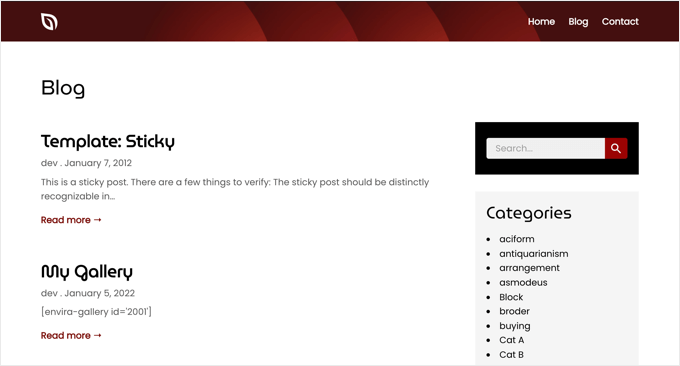
Bonus: Muestra tus entradas recientes en WordPress
Una vez que haya creado una página de blog independiente, puede seguir mostrando algunas entradas recientes en su página de inicio para animar a los usuarios a explorar más su sitio.
Para ello, abra su página de inicio en el editor de bloques de WordPress. Una vez allí, haga clic en el botón “Añadir bloque” situado en la esquina superior izquierda de la pantalla para abrir el menú de bloques.
A partir de aquí, sólo tienes que añadir el bloque “Últimas entradas” a la página. Una vez hecho esto, puedes personalizar la lista de entradas recientes para mostrar extractos de entradas, nombres de autores y fechas a tu gusto.
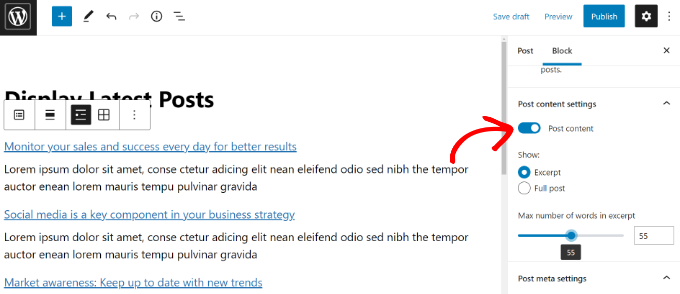
Por último, haz clic en el botón “Publicar” de la parte superior para guardar tus ajustes. Ahora, algunas de tus entradas recientes seguirán apareciendo en la página de inicio para que los usuarios pasen más tiempo en tu sitio web.
Para más información, puede consultar nuestro tutorial sobre cómo mostrar entradas recientes en WordPress.
Esperamos que este tutorial te haya ayudado a aprender cómo crear una página separada para entradas de blog en WordPress. Puede que también quieras aprender cómo añadir un estado de entrada personalizado para entradas de blog en WordPress o comprobar nuestra lista de los mejores plugins de entradas relacionadas para WordPress.
If you liked this article, then please subscribe to our YouTube Channel for WordPress video tutorials. You can also find us on Twitter and Facebook.




Krystian
I can’t figure that one out
I wanted to add some guest posts to my blog, but I want them to be in the separate category (available thru the menu).
For that I created new category, put it up in the menu and I selected the guest post to be visible only in that category (tick box), but when I publish it, it appears in both: my guestpost category (available from the menu) and on my main .com site, where I have all my other posts listed.
How can I turn it off from the main site?
Krystian
Sarah
Hi, just started my blog and am wondering How many posts WordPress keeps on the same page before having a “see older posts” button at bottom to take you to the next page? My homepage is getting longer and longer by the minute lol. Thanks!
Rhys
Hi Sarah,
You can change the amount of posts you show per page in WordPress Admin > Settings > Readying. The default is 10 from what I understand, although you can change this to whatever you feel like. The more posts per page, the slower load times you may incur.
All the best,
Ruth
Very clearly explained and wonderfully helpful. I had my blog page up and populated within minutes of watching your video. Thank you!
Ronnie
I load the sample page created by wordpress on localhost, it show properly BuT WHEN I access it thru another computer on a different internet, it show not properly.
nishant saraswat
i create my website at wordpress and now i want to create my site user friendly and beautiful i know html and some of javascript,css and php but not completly.i want to create my site beautiful either from some codings or from without codings.so,please help me to create my website.that how i create functions for users to look my site comfort to them please tell me whole process.i create a website by hostgator and sent you my reciept details.please help me i have followed you.
WPBeginner Support
First you need to choose a theme. After that if you want to further customize then you can create a child theme. There are several tools that you can use like CSS Hero and a page builder to quickly create beautiful pages with out writing much code.
Admin
Maya
What if those options are not available under template when creating a new page?
WPBeginner Support
The template names may vary from one theme to another.
Admin
Sally E
Hello,
I’m using the customizr theme and I like how it looks with blog posts showing up on the home page for now.
I would also like to have a “blog” page that links to blog posts as well since later I’ll be writing items that won’t go under the blog tab.
Is there a way to have the blog posts show up on the home page as well as on a separate page?
Thanks in advance!
Rosalinde
I have the same problem, I would love to know how to use the default homepage of the theme and a blog page that links to blog posts.
chibueze
Please, why is it that when I post in my blog, it displays all the contents of my post on that page, including images and Writings
WPBeginner Support
By default WordPress shows full post on all pages. This can be changed by using excerpts. Please see our guide How to customize WordPress excerpts no coding required.
Admin
Michelle
Like many others, I’ve been trying everything to figure this out…thank you for making it so easy!!!
Kristy
After a long, frustrating day of trying to figure this out, I will sleep a little better tonight. It now seems so obvious but for some reason, I just couldn’t figure it out today. I googled and read several forum posts where everyone said this was impossible & you just had to create category to handle a blog. I really didn’t like the way this looked on my site but decided I would just have to deal with it until I figured something else out. Thanks so much for this video. You have made my day! Now I’m going to check out your other articles hoping they will be helpful with my hundreds of other questions.
Tuncay
Hi,
I have a news website, I want to create a Forum Page, but the forum page should be take the news from other pages and my visitors can disscuss under the news in forum page,
how cna it be possilbe?
could you please help me on this?
Thanks
WPBeginner Support
See our guide on how to add bbPress forum for WordPress posts comments. This approach allows you to add a forum thread for each article you publish.
Admin
Harshit
Hi ,
This is a very helpful video. It really helpful to me. thank you for the tutorial. And you have a very nice voice.
thank you,
Zach
Helpful, thanks.
But it looks like my theme only has one template (“Default Template).
When I go to Pages, and try to Quick Edit my page, I only see “Default Template” in the dropdown of “Templates.”
Am I able to add/import more templates into my current theme? I couldn’t find a WPBeginner tutorial on this…
Thanks,
Zach
WPBeginner Support
Seems like your theme does not have a separate template for blog posts. You can try using the default template and see if it does what you need. Alternately, you can create a custom template of your own. See our tutorial How to create a custom page in WordPress. Please note that it requires some basic knowledge of html and php.
Admin
Zeeshan Ali Kaimkhani
good project
Gary
Grerat video, Thanks But when I changed the posts to the blog page, my custom theme home page is also showing the blogs. How do I keep the current custom theme home page and just move the blogs to the new blog page?
Thank you in advance.
Gary
WPBeginner Support
Please contact your theme support.
Admin
Mohsin
Hi thanks for your tutorial.
but i have problem
i am creating custom theme and i have multiple option on page for example page layout and enable top slider on this page but when i select posts page : blog
custom options are not working.
Elizabeth
Wonderful! Been searching for a very simple and straight forward tutorial, glad I found this site!
Lara
Your tutorial was awesome, thank you so much! So simple and straightforward, you helped me get my blog up and running in a few minutes. You rock!
Debbie
My problem is that on the blog page, where just the excerpts are, it reads about the first 55 words of my blog posts, but then there is no “More” or anything for them to click to read the entire post. How do I create that? They can click the image of the post, and it takes them to the full post, but there is no information that says to do that. I’m stumped!
Stephanie
OMG this was SO helpful. As a novice blogger I was finding it so impossible to create a blog post page and include that page on my menu. I can’t tell you how many times I attempted to do this in the most complicated ways. Thank you for the EASY and FAST tutorial! I am so happy!
Diane Lee
Thank you for this tutorial. I’m new to WordPress, and this was very helpful!
Ted Sherwood
Syed and team. First, thanks for a very helpful site. It’s now the first place I go to for WordPress help.
I have a theme that allows my latest posts or a static page for the front page. I already have many blog posts. And I have an existing page that I could use, with a couple of additions probably, as my front page. So I interpreted the above article as implying that I don’t need to create any new pages. However, when I try and follow your Settings/Reading instructions, there is no option under Posts for the blog page, just all the other existing pages. Perhaps there’s something I’ve missed?
WPBeginner Support
The article does mention that you need to create a new page for your blog posts.
Admin
Jason G
Very helpful especially if you have not been using a blog and are only accustomed to static pages on your sites. Thanks!
Arfa
Hey syed
Though the article is really helpful and I am succeeded in adding pages to my blog but can you please tell me how to add a post in that particular page like i have added page titled as food for thought and i have to add a post in that, how can i do that ?
Please advice.
Patti
I’m having the same issue….
Harold Buchman
Excellent tutorial –
One thing to look out for:
My custom blog page did not work while I was signed in as the administrator on my WP control panel in another browser window. As soon as I signed out, the link worked exactly as describe.
Charli
I don’t have the reading settings option… do you know what i should do ?
Abel
Good enough i hadn’t yet published my website to the world This is so helpful.. I would have forget-en how to do this and ended up ridiculously frustrated.
Heather
Thanks for the help—but I have another question kind of related..
Every post i create in my wordpress is appearing in my BLOG section..even though I do not have the ‘blog’ category (or any for that matter checked before publishing.
Here’s my site – –can you help
elizabeth
What if I want to create 2 pages but those 2 pages should have my blog posts. for eg: one page should blogs about clothing and another page should have blogs about “jewellery”
Judi Sutherland
My understanding is that you can’t have two pages of blog – only one on any site. Unless anyone knows different.
Steve
You can have as many blog pages as you like if you create custom page templates with the WordPress loop in each. This is more a nudge in the right direction than a complete answer. Hope it helps some
Riaz
Been searching hours for this, thank you Syed!
Christina Elizabeth
Thank you for this tutorial. It has been very useful. I now have a menu of separate categories for my blog. I will be back I am sure!
rovingjay
Worked like a charm … thanks for the really helpful video. I’ve been wanted to switch to a static home page but didn’t know how to also have a blog post page – one simple search and I found wpbeginner! Really appreciate it. thanks, Jay
aprav kumar
Thanks but After i did this Widgets missing from Blog Page
I am using Minamaze theme
and using plugin “eCommerce Product Catalog” by impleCode for product catalog ,since i dont want sidebar widgets to appear in all pages I used plugin “Widget logic” to make widgets appear just 2 pages which are “Blog” post page and “Products” Page .
And then all the posts are appearing in “Home” Page which is front page , so i changed “Static Front Page” Option from “Latest posts” to “Static Page” and FrontPage to Home and Posts Page to Blog , The moment i saved …. Widgets in “Blog” Page dissappeard but in “products” page it is showing up …..
Please Help me with this…. I am newbie in WordPress( just 2 days)
Jenny
this is happening to me, too, did you get an answer?
WPBeginner Staff
Many WordPress themes use a full width page template for pages with no sidebars. You can see if there are multiple templates available by editing the page in WordPress. When you will edit the page on your right hand you will see a meta box labeled templates with a dropdown menu. Try switching templates to see if you have one with the sidebar.
Jonella
I have a Blog page already. The blog posts appeared when I made a page edit and then they didn’t. I tried to revert back to the previously saved version but the posts aren’t there anymore. I can find the posts in the Posts section, they’re just not “connecting” to the Blog page anymore if that makes sense. I’m slightly panicking. Can someone help me out?
Ojabierto
Thanks a lot, you saved my night!
WPBeginner Staff
Jill this means your blog page is not working correctly, please follow the instructions carefully again.
Jill
This worked great for me but my blog page doesn’t have my blogs on – they are showing on the home page in a list in sidebar with “Archive”
Aniee
Nice , Could you explain a bit will the Seo work? in same way ? please elaborate. wile creating a seperate blog page , will seo of the website as a whole be effected, i mean with ‘/blog’ is better or just http://www.website.com , or both are same ? (in regards to seo)
Henrique
This was really useful and fast to read/implement, thanks!
WPBeginner Staff
Twenty Thirteen supports templates.
sumeet kumar
i can not understand the blog and cms in websites. please help…..
David
Looks like Twenty Thirteen, the theme I am using, doesn’t support this template feature which Twenty Twelve has. Right? What’s the solution in this case then? Any ideas?
Francois
How do I get the posts on my homepage I made a blog to display the posts as a list?
WPBeginner Staff
Did you try disabling comments on the home page by editing it?
Your blog page is just a placeholder. You are not supposed to edit it. The display of your blog entries on that page is handled by your theme.
Go to pages and edit the blog page. Under Page Attributes meta box, select default template and save your changes.
Hope this helps.
Claudius_II
Am attempting to create a blog on a blog page and have a fixed front page for my website. Have followed all your instructions as above and still comments [or blogs?] appear on the front page.
The blogs page has no fields for inserting comments or blog entries. I’ve disabled comments for this page so only blog comments should appear here.
Under Reading Settings have done exactly what you illustrate, a static front page and blogs to a blogs page. Have a menu item on my front page aslo which goes to blogs page. Blogs page exists but is unwritable.
What am I doing wrong?
Using the commercial “X” theme.
site is here:
Note some page links not working for all pages.
Thanks very much for any help.
firdaus
thanks. it works just nice
Anne
I’ve spent hundreds of dollars on books and courses to try to learn WordPress. Your tutorials are the first thing that finally enabled me to do what I need to do with my website. Thank you!
SmartglassesHQ
This is so helpful.. I always forget how to do this and end up ridiculously frustrated. I’ll try to remember for next time.
Yousuf Atik
Is there a way to post blog entries in different pages of the site? I would like to divide my blog into 3 section and post different blog entries in the different pages
WPBeginner Staff
Yes, there are several ways to do this. You can create categories for each section and use the categories in your site’s navigation menu. Then you can use a static page as your site’s front page.